Disaster Medicine Handbook: A Quick Reference
The 4 S’s of Surge Capacity
Surge capacity refers to the ability to assess and care for a large increase in patients, which is often more than a healthcare system can handle during normal operations.
Managing a surge successfully depends on four critical components: Staff, Stuff, Structure, and Systems.

Staff
Having enough people during a disaster response is critical. Staffing includes more than just clinicians and nurses. Pharmacists, phlebotomists, laboratory technicians, respiratory therapists, environmental services personnel, and security staff all have roles to play during a surge.
Staff should be prepared to expand and be flexible in their roles. For example, many subspecialists and trainees provided care in the intensive care unit and hospital for COVID patients. Click here to read about Pandemic Preparedness: COVID-19 Lessons Learned in New York's Hospitals.
Having clear communication of who responds to a disaster and their specific roles is crucial - no matter where you work.
While it may seem like having a large number of people show up to help is a good thing, too many people can lead to unnecessary crowding and inefficiency. One way to manage and deploy staff is creating a disaster labor pool.
 |
Does the place where you work have a process for calling in help in the event of a surge? |
Stuff
Supplies may be limited. This may be due to supply chain disruption or simply because the disaster has made it very difficult to get supplies to where you are working.
Examples from the COVID-19 pandemic include shortages of:
-
Personal protective equipment (PPE)
-
Ventilators and other medical equipment
-
Medications
-
Basic necessities like patient beds, linens, and food
Planning for supply needs ahead of time can help facilities respond more effectively when a surge hits.
 |
What supplies does your facility need to continue operations? What does your supply chain look like? |
Structure/Space
Structure refers to the available facilities and spaces to provide care. To accommodate a large number of patients, it’s often necessary to be creative in space utilization. Some examples may include:
-
Converting private patient rooms to shared rooms and grouping patients with similar diseases
-
Establishing alternate care sites (e.g., gymnasiums, parking garages)
-
Converting existing areas to accommodate patient influx
-
Convert outpatient clinics to urgent cares/emergency departments
-
Operating rooms with ventilators become alternative intensive care rooms
 |
Can you identify any space at your place of work that can serve as alternative areas for providing care? |
System
Set up a command center. Clear communication up and down the chain of command is critical for everyone to have a shared mental model. Use the Incident Command System to coordinate roles and decisions.
Build partnerships with community organizations, healthcare networks, and public health agencies. They may help share the load or provide vital resources.
 |
What partnerships already exists for you? Can you identify other potential partners? |
Resources:
-
ASPR: Medical Surge Capacity and Capabilities (MSCC) Handbook
- Baker AH, Lee LK, Sard BE, Chung S. The 4 S's of Disaster Management Framework: A Case Study of the 2022 Pediatric Tripledemic Response in a Community Hospital. Annals of Emergency Medicine, Volume 83, Issue 6, 568 – 575. DOI: 10.1016/j.annemergmed.2024.01.020
Written by Dennis Ren
Last updated:11/10/2025